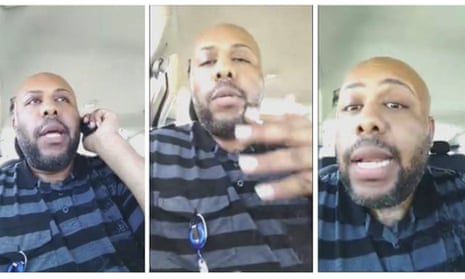The old adage “be careful what you wish for” comes to mind. A while back, Facebook launched Facebook Live, a service that enables its users to broadcast live video to the world. Shortly after the service was activated, the company’s founder and CEO, Mark Zuckerberg, said that the service would support all the “personal and emotional and raw and visceral” ways that people communicate. Users were encouraged to “go live” in casual settings – waiting for baggage at the airport, for example, or eating at a restaurant.
Note the phrase “raw and visceral”. Facebook Live has already broadcast a live stream of a young disabled man being tied up, gagged and attacked with a knife. In March, two Chicago teenage boys live-streamed themselves gang-raping a teenage girl. And around 40 Facebook users watched the video without reporting it either to Facebook or the police.
That’s pretty raw and visceral, you might think. But it turns out that it was just a prelude. Last Sunday morning, Robert Godwin, a 74-year-old man, was walking along a street in Cleveland, Ohio, minding his own business. He was approached by a 37-year-old named Steve Stephens, who asked him to say the name “Joy Lane”. Godwin complied, after which Stephens shot him dead. Stephens then uploaded three videos to Facebook, between 11.09am and 11.22am. In the first, he announced his intent to commit murder. Two minutes later, he uploaded a video of the shooting. Then, at 11.22am, he live-streamed his video confession. Facebook received its first report of the killing at 12.59pm and disabled Stephens’s account 23 minutes later. Joy Lane turned out to be the name of his girlfriend, with whom he had allegedly been having difficulties.
Facebook, naturally, is appalled by all this. “This is a horrific crime and we do not allow this kind of content on Facebook,” a spokeswoman said in a statement emailed to the Washington Post. “We work hard to keep a safe environment on Facebook and are in touch with law enforcement in emergencies when there are direct threats to physical safety.”
Quite so. But what’s this? The company has an official blog dedicated to Facebook Live. “Since rolling out Facebook Live,” says the entry for 18 April – that’s two days after Godwin’s murder – “we’ve seen people and publishers around the world seize the opportunity to share their experiences as they happen, especially during key cultural moments. We’ve been inspired by the creativity we’ve seen.”
So we’re seeing a pattern emerging: a small proportion of Facebook users (and since there are nearly 2 billion of them, that’s a significant number of people) are psychopaths, sociopaths or lunatics. Some enjoy inflicting pain on others and – worse – get a kick out of broadcasting their acts to the world. Until recently, this latter craving has been difficult to gratify. But now digital technology, in the form of apps such as Periscope and services such as Facebook Live, has come to the rescue. Think of it as the Psychopaths ’R Us channel.
Any normal company that had a product capable of producing such toxic outcomes would shut it down and write off the costs. But Facebook isn’t a normal company: it makes its money not from selling stuff to us, but from analysing our digital shares, likes and clicks and monetising them by selling that data to advertisers, who hope their ads can thereby be targeted more accurately. It seems Facebook can charge more for ads that are linked to videos, so its Live service is potentially a big earner. Given this, the PR hassle that comes from occasional abuse of the service by psychopaths is just the cost of doing business. Besides, wouldn’t it be wrong to allow a few nutters to stifle the creativity of people wanting to “share their experiences as they happen, especially during key cultural moments”?
“All Human Life Is There” used to be a slogan for the now-defunct News of the World. It was never true of that organ, which specialised in randy vicars, pools winners and showbiz celebs. But it is true of the internet, which is what we’re learning; not just from Facebook Live, but from social media generally. It’s as if the net holds up a mirror to human nature. Much of what we see reflected is banal and predictable, but some of the things it tells us about ourselves are, like Godwin’s murder, deeply troubling.
Which is probably why Facebook thinks that we shouldn’t shoot the messenger. It’s a variant of the National Rifle Association’s argument: guns don’t kill people – it’s people who kill people. And it’s baloney.

